Liste von byzantinischen Festungen und sonstigen Bauwerken im Maghreb

Die Liste von byzantinischen Festungen im Maghreb verzeichnet Fotos der zwischen 533 und 698 errichteten Festungen auf dem Territorium des byzantinischen Reiches im Maghreb. Sie dienten zum einen der Befriedung der Berber innerhalb des Reiches und zum anderen der Abwehr äußerer Feinde.
Hintergrund
Die seit 439 im Kernland des vormals weströmischen Reiches herrschenden Vandalen hatten erhebliche Schwierigkeiten, die Landesgrenzen gegen die Berber zu verteidigen beziehungsweise die unter vandalischer Herrschaft stehenden Berber unter Kontrolle zu halten,[1] was Großgrundbesitzer und auch Kleinbauern dazu veranlasste, ihre Höfe zu befestigen.[2] Nach der oströmischen Rückeroberung der im 5. Jahrhundert durch die Vandalen eroberten Gebiete und erneuten Unterwerfung von im gleichen Zeitraum etablierten römisch-berberischen Kleinstaaten wurden dort diverse Festungen sowohl an der Grenze[3] als auch innerhalb des oströmisch beherrschten Gebietes angelegt.[4] Zum Teil wurden auch kleinere römische Forts instand gesetzt.
Wesensmerkmale
Der Bau der Festungen erfolgte im Wesentlichen in der zweiten Amtszeit des Prätorianerpräfekten Solomon 539 bis 544, wobei als Baumaterial häufig die Substanz älterer römischer Bauwerke benutzt wurde. Die meisten der Festungen sind deutlich kleiner als ihre römischen Vorgänger und meistens als Forts zu klassifizieren. Viele dieser Festungen wurden anschließend durch die Araber und Osmanen weiter genutzt und umgebaut. In Teilen dienten sie sogar als stilistische Vorlage für den Bau eigener Festungen. Zudem wurde Baumaterial byzantinischer Bauwerke für den Bau etlicher arabischer Festungen verwendet, wie zum Beispiel das Fort Sidi Salem Bou Ghara bei der römischen Stadt Gigthis.[5] Die Identifikation einer Festung im Maghreb als byzantinisch wird hierdurch in erheblichem Maße erschwert.
Übersicht
| Name (Latein) | Beschreibung | Standort | Entstehungszeit | Fläche | Bild |
|---|---|---|---|---|---|
| Aggar | Binnenfestung im Süden von Africa Proconsularis | Sidi Amara | k. A. | 0,05 ha |  |
| Ammaedara | Binnenfestung im äußersten Westen der Byzacena | Haïdra | zwischen 534 und 565[6] | 2,55 ha |  |
| Capsa | Grenzfestung im Süden der Byzacena | Gafsa | k. A. | k. A. | 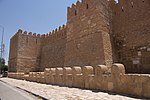 |
| Chusira | Binnenfestung | La Kesra | wohl zwischen 534 und 565, eher vor 544[7] | 0,28 ha | 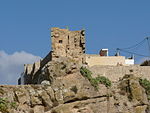 |
| Civitas Vazitana Sarra | Binnenfestung in Africa Proconsularis | Henchir-Bez | k. A.[8] | 0,06 ha |  |
| Clupea | Binnenfestung zum Schutze der Stadt, wurde in osmanischer Zeit umgebaut | Kelibia | k. A. | k. A. |  |
| Cuicul | Binnenfestung zum Schutze der gleichnamigen Stadt in der Mauretania Sitifensis | Djémila | k. A.[9] | 0,03 ha | 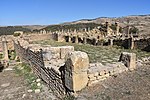 |
| Gadiaufala | Binnenfestung in Numidien | Ksar Sbahi | zwischen 539 und 544[10] | 0,16 ha | https://www.leguidetouristique.com/ruinesbr/fort-byzantine-gadiovala-ksar-al-sobihi |
| Iunci | Binnenfestung an der Küste der Byzacena | (Younga) bei Sfax | in der Amtszeit von Justin II. (566–578)[11] | k. A. |  |
| Lamasba | Grenzfestung im Belezma-Gebirge, häufig auch Ksar Belezma genannt | Mérouana | zwischen 536 und 544[12] | 1,4 ha |  |
| Lambaesis | Grenzfestung südlich des Belezma-Gebirges | Tazoult-Lambèse | k. A.[13] | k. A. |  |
| Leptis Magna | Befestigte Stadt an der Küste Tripolitaniens | Leptis Magna | wohl zwischen 533 und 565[14] | 28 ha | (c) Paul Dober, CC BY 3.0 |
| Limisa | Binnenfestung im Norden der Byzacena | Ksar Lemsa | wohl zwischen 585 und 600[15] | 0,09 ha |  |
| Mactaris | Binnenfestung in Africa Proconsularis | Maktar | k. A.[16] | 0,35 ha |  |
| Madauros | Binnenfestung nahe der Küste in der Mauretania Sitifensis | Madauros | zwischen 534 und 544[17] | 0,24 ha |  |
| Musti | Binnenfestung in Africa Proconsularis | Mustis | k. A.[18] | 0,2 ha | 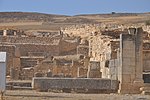 |
| ? | Binnenfestung | Ksar El Hadid | k. A. | k. A. |  |
| Oea | Befestigte Stadt an der Küste Tripolitaniens | Tripolis | Vermutlich durch die Phönizier im 7. Jahrhundert vor Christus | k. A. |  |
| Sabratha | Befestigte Stadt an der Küste Tripolitaniens | Sabrata | wohl zwischen 533 und 565[19] | 9,0 ha |  |
| Sicca Veneria | Binnenfestung zum Schutze der Stadt | El Kef | wohl zwischen 533 und 565[20] | k. A. | 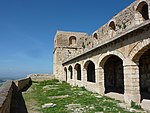 |
| Sitifis | Binnenfestung zum Schutze der Stadt | Sétif | zwischen 539 und 544[21] | 1,69 ha |  |
| Suas | Binnenfestung in Africa Proconsularis | Chaouach | k. A. | k. A. |  |
| Sufetula | Binnenfestung im äußersten Südwesten der Byzacena | Sbeitla | k. A. | k. A. |  |
| Thamugadi | Grenzfestung in Numidien | Timgad | 539/540[22] | 0,75 ha | 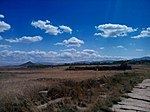 |
| Thagura | Binnenfestung in Numidien | nahe Souq Ahras | 539/wohl 548 („vor Theodoras Tod“)[23] | 0,53 ha | https://www.leguidetouristique.com/ruinesbr/thagura-taoura |
| Theveste | Befestigte Stadt im Osten Numidiens | Tebessa | zwischen 536 und 544[24] | 7,5 ha |  |
| Thignica | Binnenfestung in Africa Proconsularis | Ain Tounga | wohl nach dem Tod von Justinian I. 565[25] | 0,28 ha | 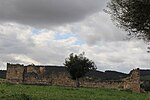 |
| Tipasa | Basilika an der Küste von Mauretania Prima | Tipasa | k. A. | k. A. | 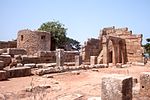 |
| Tipasa | Binnenfestung, ggf. Stadtbefestigung in Numidien | Tifech | vermutlich vor 553[26] | 2,25 ha [27] | https://harba-dz.com/annuaire-algerie/41-wilaya-de-souk-ahras/site-de-tiffeche-tipaza-de-numidie/ |
| Tubunae | Grenzfestung in Mauretania Sitifensis | Tobna | im 6. Jahrhundert, keine näheren Angaben[28] | 0,50 ha | https://www.leguidetouristique.com/ruinesbr/tobna |
| Tubernuc | Bauwerk unbekannter Zweckbestimmung in Africa Proconsularis | nahe Grombalia | k. A. | k. A. |  |
| Vaga | Binnenfestung in Numidien | Beja (Tunesien) | vor dem Tode der Kaiserin Theodora 548[29] | k. A. |  |
| Vescera? | Mögliche Grenzfestung in Numidien | Biskra | k. A. | k. A. |  |
| Zabi | Mögliche Grenzfestung in Mauretania Sitifensis[30] | M'Sila, Ortsteil Bechilga | k. A. | k. A. | |
| Zaga? | Mögliche Binnenfestung in Africa Proconsularis[31] | Ksar Zaga | k. A. | k. A. |  |
| Zucchara | Binnenfestung im Süden von Africa Proconsularis | Ain-Djoukar | k. A. | k. A. |  |
Anmerkungen
- ↑ Denys Pringle: The Defence of Byzantine Africa from Justinian to the Arab Conquest. British Archaeological Reports, Oxford 1981, ISBN 0-86054-119-3 (Nachdruck 2001), S. 97.
- ↑ vgl. Averil Cameron: Vandal and Byzantine Africa in: Averil Cameron, Bryan Ward-Perkins, Michael Whitby (Hrsg.): The Cambridge Ancient History. Band 14: Late Antiquity. Empire and Successors. AD 425–600. Cambridge University Press, Cambridge 2000, ISBN 0-521-32591-9, S. 556.
- ↑ Denys Pringle: The Defence of Byzantine Africa from Justinian to the Arab Conquest. British Archaeological Reports, Oxford 1981, ISBN 0-86054-119-3 (Nachdruck 2001), S. 28 f.
- ↑ Susan Raven: Rome in Africa. 3. Auflage, Routledge, London u. a. 1993, ISBN 0-415-08150-5, S. 214 f.; vgl. auch Gabriele Crespi: Die Araber in Europa. Sonderausgabe, Belser, Stuttgart 1992, ISBN 3-7630-1730-5, S. 27 zu den Gründen.
- ↑ D. Pringle: The Defence of Byzantine Africa from Justinian to the Arab Conquest, Oxford 1981, S. 295.
- ↑ D. Pringle: The Defence of Byzantine Africa from Justinian to the Arab Conquest, Oxford 1981, S. 180; François Baratte, Fathi Bejaoui: Les fortifications byzantines d’Ammaedara. In: Comptes rendus des séances de l'Académie des Inscriptions et Belles-Lettres 2010, S. 513–538 (Digitalisat).
- ↑ D. Pringle: The Defence of Byzantine Africa from Justinian to the Arab Conquest, Oxford 1981, S. 193., S. 320.
- ↑ D. Pringle: The Defence of Byzantine Africa from Justinian to the Arab Conquest, Oxford 1981, S. 303.
- ↑ D. Pringle: The Defence of Byzantine Africa from Justinian to the Arab Conquest, Oxford 1981, S. 294.
- ↑ D. Pringle: The Defence of Byzantine Africa from Justinian to the Arab Conquest, Oxford 1981, S. 198.
- ↑ D. Pringle: The Defence of Byzantine Africa from Justinian to the Arab Conquest, Oxford 1981, S. 202.
- ↑ D. Pringle: The Defence of Byzantine Africa from Justinian to the Arab Conquest, Oxford 1981, S. 204.
- ↑ D. Pringle: The Defence of Byzantine Africa from Justinian to the Arab Conquest, Oxford 1981, S. 282.
- ↑ D. Pringle: The Defence of Byzantine Africa from Justinian to the Arab Conquest, Oxford 1981, S. 208.
- ↑ D. Pringle: The Defence of Byzantine Africa from Justinian to the Arab Conquest, Oxford 1981, S. 212.
- ↑ D. Pringle: The Defence of Byzantine Africa from Justinian to the Arab Conquest, Oxford 1981, S. 264
- ↑ D. Pringle: The Defence of Byzantine Africa from Justinian to the Arab Conquest, Oxford 1981, S. 216; Bernd Päffgen: Das justinianische Kastell von Madauros in Ost-Algerien. In: Kölner Jahrbuch 43, 2010, S. 515–530.
- ↑ D. Pringle: The Defence of Byzantine Africa from Justinian to the Arab Conquest, Oxford 1981, S. 266
- ↑ D. Pringle: The Defence of Byzantine Africa from Justinian to the Arab Conquest, Oxford 1981, S. 226.
- ↑ D. Pringle: The Defence of Byzantine Africa from Justinian to the Arab Conquest, Oxford 1981, S. 226.
- ↑ D. Pringle: The Defence of Byzantine Africa from Justinian to the Arab Conquest, Oxford 1981, S. 227.
- ↑ D. Pringle: The Defence of Byzantine Africa from Justinian to the Arab Conquest, Oxford 1981, S. 232f.; Jean Lassus: La forteresse byzantine de Thamugadi. Edition du Centre National de la Recherche Scientifique, Paris 1981, ISBN 2-222-02676-8.
- ↑ D. Pringle: The Defence of Byzantine Africa from Justinian to the Arab Conquest, Oxford 1981, S. 232f.
- ↑ D. Pringle: The Defence of Byzantine Africa from Justinian to the Arab Conquest, Oxford 1981, S. 239.
- ↑ D. Pringle: The Defence of Byzantine Africa from Justinian to the Arab Conquest, Oxford 1981, S. 40.
- ↑ D. Pringle: The Defence of Byzantine Africa from Justinian to the Arab Conquest, Oxford 1981, S. 274.
- ↑ D. Pringle: The Defence of Byzantine Africa from Justinian to the Arab Conquest, Oxford 1981, S. 274.
- ↑ D. Pringle: The Defence of Byzantine Africa from Justinian to the Arab Conquest, Oxford 1981, S. 275.
- ↑ D. Pringle: The Defence of Byzantine Africa from Justinian to the Arab Conquest, Oxford 1981, S. 250.
- ↑ zweifelnd etwa D. Pringle: The Defence of Byzantine Africa from Justinian to the Arab Conquest, Oxford 1981, S. 252.
- ↑ zweifelnd etwa D. Pringle: The Defence of Byzantine Africa from Justinian to the Arab Conquest, Oxford 1981, S. 304.
Literatur
- Denys Pringle: The Defence of Byzantine Africa from Justinian to the Arab Conquest. An Account of the Military History and Archaeology of the African Provinces in the Sixth and Seventh Century (= British Archaeological Reports. International Series 99). British Archaeological Reports, Oxford 1981, ISBN 0-86054-119-3 (Nachdruck 2001).
- Averil Cameron: Vandal and Byzantine Africa. In: Averil Cameron, Bryan Ward-Perkins, Michael Whitby (Hrsg.): The Cambridge Ancient History. Band 14: Late Antiquity. Empire and Successors. AD 425–600. Cambridge University Press, Cambridge 2000, ISBN 0-521-32591-9, S. 552–569.
- Susan Raven: Rome in Africa. 3. Auflage, Routledge, London u. a. 1993, ISBN 0-415-08150-5, S. 209–230.
Weblinks
- weitere, urheberrechtlich bei Wikipedia nicht verwertbare Bilder: Résultats de recherche pour : fort byzantin
Auf dieser Seite verwendete Medien
(c) OOjs UI Team and other contributors, MIT
An icon from the OOjs UI MediaWiki lib.
Autor/Urheber: Noomen9, Lizenz: CC BY-SA 4.0
Dieses Bild zeigt das unter der Nummer 21-21 aufgeführte Denkmal in Tunesien.
Autor/Urheber: Credits to Reda Kerbush / Wikimedia Commons, Lizenz: CC BY-SA 3.0
Dieses Bild zeigt das Denkmal in Algerien mit der Nummer
Autor/Urheber: Sergey Prokopenko, Lizenz: CC BY-SA 3.0
View of the Kelibia (Tunisia) citadel and harbor
Autor/Urheber: Dennis Jarvis, Lizenz: CC BY-SA 2.0
Byzantine fort (on the right) in ancient Sbeitla
Autor/Urheber: User:Robamler, Lizenz: CC BY-SA 4.0
Remains of Byzantine city walls
Autor/Urheber: Noomen9, Lizenz: CC BY-SA 4.0
Dieses Bild zeigt das unter der Nummer 34-22 aufgeführte Denkmal in Tunesien.
Autor/Urheber: Brahim Guedich, Lizenz: CC BY-SA 4.0
The kasbah, Gafsa's fortress
Autor/Urheber: Zeinebtakouti, Lizenz: CC BY-SA 4.0
Forteresse Byzantine de Ain Tounga
Ruines du site antique Madaure (Madaura, Madaurius, M'daourouch)
Autor/Urheber: Abdulfatah Amr, Lizenz: CC BY-SA 4.0
The Red Castle Museum, also known as Assaraya Alhamra Museum (Arabic: متحف السرايا الحمراء) or the Archaeological Museum of Tripoli, is a national museum in Libya. It is located in the historic building known as the Red Castle or Red Saraya. Designed in conjunction with UNESCO, the museum covers 5,000 years from prehistory to the independence revolution (1953) era.[1] It is located in Tripoli's Assaria al-Hamra or Red Castle fortress, on the promontory above and adjacent to the old-town district with medina Ghadema. The museum has an entrance on historic As-Saha al-Kradrah, the Martyrs' Square.[2]
Autor/Urheber: IssamBarhoumi, Lizenz: CC BY-SA 4.0
Dieses Bild zeigt das unter der Nummer 61-2 aufgeführte Denkmal in Tunesien.
(c) Paul Dober, CC BY 3.0
gate design has survived more than 2000 yrs at Leptis Magna
Autor/Urheber: Noomen9, Lizenz: CC BY-SA 4.0
Vue sur la forteresse byzantine de Mustis
Autor/Urheber: IssamBarhoumi, Lizenz: CC BY-SA 4.0
Dieses Bild zeigt das unter der Nummer 41-18 aufgeführte Denkmal in Tunesien.
Autor/Urheber: David Stanley from Nanaimo, Canada, Lizenz: CC BY 2.0
The design of the 8th century Ribat at Sousse, Tunisia, was inspired by Byzantine fortresses; the tower served as a minaret for the Islamic warrior garrison
Autor/Urheber: IssamBarhoumi, Lizenz: CC BY-SA 4.0
Fortin byzantin
Autor/Urheber: Batni, Lizenz: FAL
Fort Byzantin aux contreforts du massif montagneux Belezma
Autor/Urheber: Following Hadrian, Lizenz: CC BY-SA 2.0
Cuicul (Djémila), Numidia, Algeria
Autor/Urheber: Youssefbensaad, Lizenz: CC BY-SA 4.0
Grande citadelle reconstruite sous Justinien
Autor/Urheber: Noomen9, Lizenz: CC BY-SA 4.0
Dieses Bild zeigt das unter der Nummer 31-66 aufgeführte Denkmal in Tunesien.
Autor/Urheber: Yelles, Lizenz: CC BY-SA 3.0
Ruins of the Byzantine era Basilica of St. Crispinus — in Tipaza, northern Algeria.
Autor/Urheber: El Golli Mohamed, Lizenz: CC BY-SA 4.0
Dieses Bild zeigt das unter der Nummer 31-98 aufgeführte Denkmal in Tunesien.
Autor/Urheber: Astiosaurus, Lizenz: CC BY-SA 3.0
Ruines de la ville romaine et du fort byzantin
Autor/Urheber: Séraphin Médéric Mieusement , Lizenz: CC BY-SA 4.0
Enceinte extérieure.
Autor/Urheber: Pradigue, Lizenz: CC BY 3.0
Grands thermes sud de Makthar
































